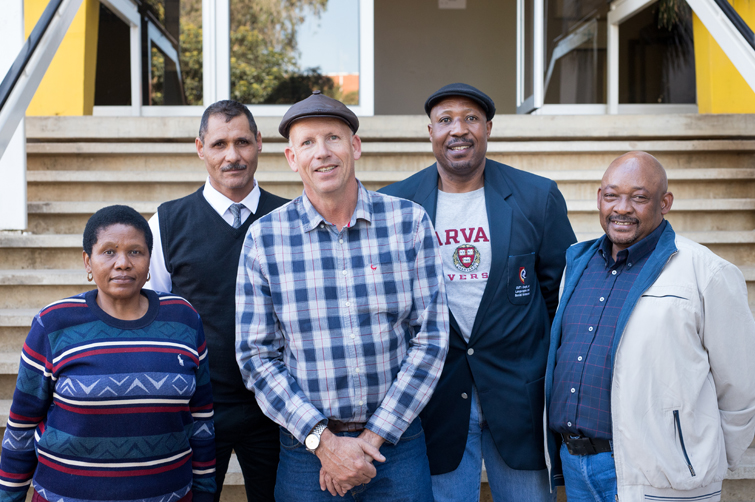Latest News Archive
Please select Category, Year, and then Month to display items
13 January 2020
|
Story Eugene Seegers
|
Photo Anja Aucamp
 Spearheading the digital expansion of the conversational Sesotho course is IDEAS Lab Director, Johann Möller (middle). With him are from the left: Prof Pule Phindane, CUT; Dr Brenton Fredericks, CUT; Bahedile Letlala, UFS Department of African Languages; and Dr Elias Malete, UFS Department of African Languages.
Spearheading the digital expansion of the conversational Sesotho course is IDEAS Lab Director, Johann Möller (middle). With him are from the left: Prof Pule Phindane, CUT; Dr Brenton Fredericks, CUT; Bahedile Letlala, UFS Department of African Languages; and Dr Elias Malete, UFS Department of African Languages.
For many years now, the UFS has been offering a one-year course in conversational Sesotho for staff members; this can then be followed up with the one-year course in advanced conversational Sesotho. The conversational Sesotho for students in the Faculty of Education was introduced in 2018 at the UFS.
The Central University of Technology (CUT) needed a conversational course for its first-year students and approached the Department of African Languages for the development of such a course. Living as we do in a multilingual country; this additional language skill opens doors and often hearts as well.
Using instructional design principles
However, the need was identified by both CUT and UFS to present this crucial information in a way that would be more appealing to digital natives as well as to those less familiar with technology. The Department of African Languages on the UFS Bloemfontein Campus, together with relevant departments from the CUT, approached the IDEAS Lab located on the UFS South Campus, since they already have a reputation for being a specialist on broadcasting and repackaging curricular content for digital presentations. The IDEAS Lab provided technical advice and built the multimedia programme, which will help the user to hear and practice phrases in Sesotho, using instructional design principles. The course will be available to both staff and students belonging to the two universities.
Room for growth
Johann Möller, Director of the IDEAS Lab, says this pilot programme will give both institutions the opportunity to test the use of multimedia for language acquisition. He adds, “Language is extremely complex, and we would like to expand this learning aid in the future.” In fact, the original design has room for growth built into it.
To keep things simple for the user and the building team, it was decided to start out with only four potential everyday scenarios where a staff member would like to speak Sesotho: Firstly, how to greet other persons from different genders; secondly, potential scenarios one might encounter in the university environment itself; thirdly, how to deal with situations at a hospital; and finally, how to use one’s language skills at a filling station.
Pronunciation is key
Each scenario contains three to four conversations that the learner can revise, along with images and audio that illustrate the situation and assist with correct pronunciation. The system does not allow the user to progress unless they have listened to the pronunciations of the sample sentences or phrases.
Further reading material and vocabulary lists are also provided, with the result that people who are using the programme can learn at their own pace. The authoring software Articulate Storyline was used to build the individual scenarios and each conversation or lesson within it. The lessons are also not dependent on an internet connection; they can be downloaded onto a flash memory drive and used offline.
Dying of consumption: Studying ‘othering’ and resistance in pop culture
2014-10-31
 |
The Centre for Africa Studies (CAS) at the UFS – under the project leadership of Prof Heidi Hudson (CAS Director) – conceptualised an interdisciplinary research project on representations of otherness and resistance.
This is in collaboration with UFS departments such as the Odeion School of Music, the Department of Drama and Theatre Arts, the Department of Fine Arts, the Jonathan Edwards Centre Africa and the Department of Afrikaans and Dutch, German and French.
In this project, Dr Stephanie Cawood from CAS leads a sub-project on the dynamics of pop culture and consumerism. Her research unpacks and critiques pop culture representations of othering and resistance by engaging with the othering rhetoric of conspicuous consumption as well as the subversive rhetoric or culture jamming at play in various South African youth subcultures.
Consumerism has become the institutional system in which we live our daily lives. Pop culture is the result when multinational corporations take aspects of culture and turn it into commodities with high market value. In pop culture and its manifestation, consumption, marketers and savvy advertising executives have realised long ago that othering and resistance are powerful tools to artificially create empty spaces in people’s lives that can only be filled through consuming.
“The scary thing is in my opinion that everyone has become a market segment, including very young children,” says Dr Cawood.
In his 1934 book, The Theory of the Leisure Class (TLC), Thorstein Veblen coined the term conspicuous consumption to describe the conduct of the nouveau riche. He contended that when people manage to meet their basic human requirements, any additional accumulation of wealth will no longer relate to function, but will be spent on ostentatious displays of conspicuous consumption or waste. Conspicuous consumption has evolved into invidious consumption where consumption is a mark of one’s superior social status and particularly aimed at provoking envy. The whole point is unashamed one-upmanship.
“Think of the izikhotane or skothane cultural phenomenon where young people engage in ritualised and ostentatious consumerist waste for social prestige. This is an excellent example of invidious consumption.
“Instead of striving to become good citizens, we have become good consumers and none are more vulnerable than our youth irrespective of cultural and ethnic differences”.